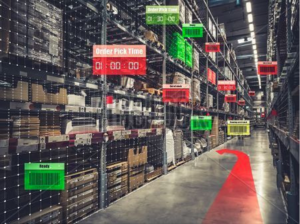If there is ever a silver lining to be found in this pandemic, then it’s definitely the way it forced both individuals and enterprises to make the most of less-than-ideal conditions — first to consider, then to adapt, and ultimately to thrive while doing things previously thought impossible.

The month of January is known for marquee retail industry events like the Consumer Electronics Show (CES), NRF Retail Show from the National Retail Federation and more. A key highlight from in the recent NRF Retail show is the keynote from Brian Cornell, CEO of Target Inc, sharing the technology transformation needed to meet the demands of the pandemic. Arrcus is privileged to have large retailers like Target and service providers like Softbank as our key customers and partners.
Seismic changes in retail shopping behavior
The pandemic has accelerated the growth of retail e-commerce by 4-6 years, with the latest data from McKinsey showing an 11% increase in year-over-year growth over the pre-COVID-19 growth trajectory.
This unprecedented growth was driven by a surge in demand for certain categories (such as groceries and home improvement) — even as lockdowns and the new work-from-home setup have prompted customers to minimize in-store visits and normalize online purchases.
Curbside pickups, also known as “Buy Online, Pickup in Store” (BOPIS) services have become ubiquitous and are here to stay.
These seismic changes in shopping behavior have exerted enormous pressure on retailers’ networks.
The Far Edge challenges
Modern retailers now need to manage an even more complex network of devices — which includes sensors and devices across multiple retail applications such as point of sale, price checks, promotions, digital signage, and more.
This “far edge” ecosystem can number in the hundreds of thousands (up to 1M devices in the case of Target) and require their own compute resources at edge locations such as big-box stores, warehouses, and distribution centers. You can learn more about Target’s foray into Edge transformation in a joint presentation with Arrcus at Open Compute Project 2021 event.
Innovating and future-proofing at the Far Edge
Retailers need to address the need for speed and agility for Far Edge workloads using a future-proof network architecture that can help them innovate and adapt to ever-changing demands.
This future-proof Far Edge network infrastructure needs to be:
- Disaggregated and open — to enable complete flexibility using disaggregated hardware and software, open software, and REST APIs.
- Independent yet fully connected — to other edge networks, to telecom and 5G communications networks, and to compute resources from multiple clouds.
- Support ultra-low latency interactions — to provide the seamless experience customers have come to expect on the front end, and to enable efficient inventory management and other essential functions on the back end.
Our Arrcus Connected Edge (ACE) platform delivers all these while providing orchestration, analytics, and automation capabilities to give retailers full control of their Far Edge network traffic, operational manageability, and granular visibility to provide a modern retail experience.
Learn how Arrcus can help future proof your Far Edge network and provide innovative retail experiences, check out our demos or contact us to schedule a discussion.